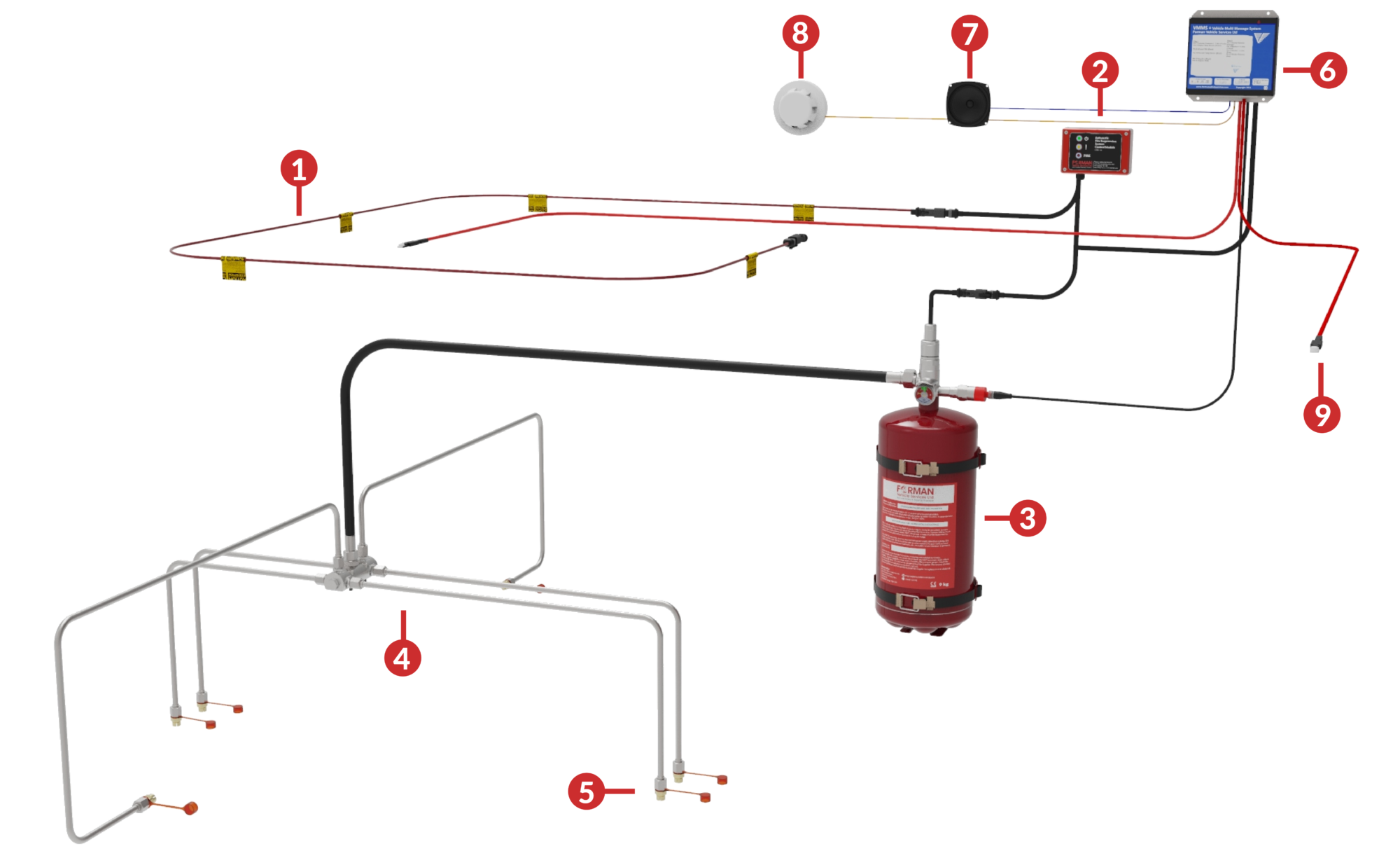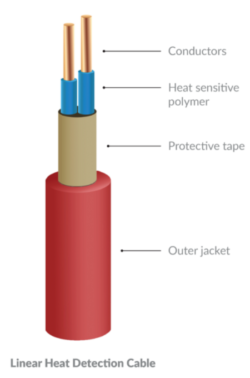Get to know our Sales Manager for the UK and Ireland, Eliott Campey, in this Meet the Team. Read on to find out what makes him tick.
BUS AND COACH FIRE SUPPRESSION
UNECE R107 APPROVED AUTOMATIC SYSTEM
UNECE R107 approved Fire Suppression System
The Forman R107 approved Fire Suppression System delivers reliable protection to engine compartments in buses and coaches.
Proven to successfully protect diesel, electric, hybrid and hydrogen vehicles, Forman’s fire suppression system offers flexible protection for all fuel sources. With electronic detection and Dry Chemical extinguishing agent, reliable automatic operation and effective protection is guaranteed.
KEY BENEFITS
Rapid and effective fire suppression
The Dry Chemical powder is highly effective at tackling most types of fires – including Class A, Class B, Class C and electrical fires.
Reliable system operation
The linear heat detection cable provides rapid fire detection while protecting against false discharges commonly caused by loss of pressure in tube systems.
Full fire hazard coverage
A complete fire risk assessment is completed for each specific vehicle, where all fire hazards that need to be protected by the fire suppression system are identified.
Easy maintenance and long life
Simple maintenance procedure with no tank agitation and a 7-year life span to ensure long-term protection with minimal disruption to operations.
UNECE Regulation No. 107
United Nations Economic Commission for Europe (UNECE) regulation No. 107 stipulates that the installation of automatic fire suppression for class III vehicles (coaches) is mandatory from July 2019, and from September 2021 for class I and II vehicles (buses of all types). The regulation aims to reduce the number of catastrophic bus fires starting in the engine bay.
Having the engine in the rear of a bus means that the driver is unlikely to notice the fire before the smoke can be seen from outside the vehicle. The regulation specifies automatic fire suppression as this doesn’t rely on the bus driver detecting the fire. The time saved means that the safety of passengers and driver is improved, and the vehicle suffers less damage significantly reducing downtime and repair costs.

The Forman R107 Approved System
The Forman R107 approved Fire Suppression System meets all UNECE R107 requirements for automatic engine bay fire suppression. The system has passed the strict fire testing protocols from the Research Institutes of Sweden (RISE) which have been adopted from the SP Method 4912 tests.
In line with the regulation, a complete fire risk assessment is completed for each specific vehicle, with the aim to identify all fire hazards that need to be protected by the fire suppression system. The risk assessment dictates key system design parameters such us number of nozzles and quantity of dry powder required to protect the identified fire hazards.
How the Forman R107 Approved System Works
The Forman Fire Suppression System uses Linear Heat Detection cable (1) that is routed around the fire hazard areas in the engine compartment. When the cable is exposed to a fire, it sends a signal to the Control Module (2) to initiate the system discharge. This process is extremely quick, allowing the system to actuate immediately to put out the fire in a matter of seconds.
The Dry Chemical ABC extinguishing agent contained in the tank (3) travels through the distribution network (4) and is discharged through critically located nozzles (5) aimed at the identified fire hazards.
The system offers an optional output to interface with the vehicle or with the Forman VMMS Multi-Message System (6). If the VMMS system is installed, the Temperature Rise Pre-Warn Sensors (9) alert the driver when temperatures exceeding normal operating temperatures are reached.
- Linear Heat Detection Cable
- Control Module
- Dry Chemical Agent Tank
- Distribution Network
- Discharge Nozzles
- VMMS Multi-Message System (optional)
- VMMS Driver's Cab Speaker (optional)
- Smoke Alarm (optional)
- Temperature Pre-Warn Sensors (optional)

Linear Heat Detection
The Forman R107 approved Fire Suppression System uses a Linear Heat Detection (LHD) cable. This cable is easily routed around the fire hazard areas in the engine compartment to provide rapid fire detection.
LHD is a form of electronic detection that works using conductors surrounded by heat sensitive polymer. The polymer surrounding the conductors melt when exposed to fire temperatures. This creates a short circuit that sends a signal to the control module to activate system. It takes a matter of seconds for the system to detect and suppress the fire.
This electronic detection also means increased reliability, as the system will not suffer from false discharges which often result from damaged detection tubing or loss of pressure in tube systems.
The LHD cable can differentiate between the signal from a cut or trapped cable and that of a fire signal.
As it does not require pressure to operate, LHD cable can be easily routed around the engine bay, makings installations safer and simpler, and eliminating the risk of accidentally setting off the system during maintenance or repair works.

Optional Features
All these features are included in the Transport for London (TfL) fire suppression system specification and are designed to enhance the performance of the system.
VMMS Vehicle Multi-Message System
The Forman Fire Suppression System can be linked to the V-Series VMMS unit. This allows audible warnings to be delivered to the bus driver through a speaker installed in the driver’s cab, alerting of fire suppression system status and activation.
If additional features such as the smoke detector and temperature pre-warn sensors are included, the VMMS also delivers high temperature and smoke detected warnings to the driver.
High Temperature Pre-Warn Sensors
The high temperature pre-warn sensors are installed in the engine bay and connects to the VMMS unit. This allows the VMMS to deliver high engine temperature warnings to the driver. The sensors alert the driver when engine compartment temperatures exceed normal operating temperatures. This allows the driver to safely stop the bus, lowering the temperature of the engine and potentially preventing the fire altogether.
Smoke Detector
The smoke detector is recommended for the upper deck of double-decker vehicles. It links for the VMMS system to provide voice alerts to the driver if smoke is detected on the top deck of the bus.
CONTACT
Get in touch to find out how we can help
Make an enquiry
If you’d like to make an enquiry, please use the contact form below and we will get back to you as soon as possible.



